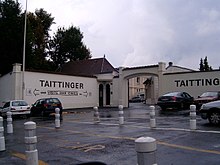Taittinger
Taittinger is in Reims ( Champagne in the north east of France beheimateter) champagne manufacturer . The company emerged in 1931 from the Forest & Fourneaux winery , which had existed since 1734. Taittinger is one of the few champagne houses that are still family-owned. Pierre-Emmanuel Taittinger was managing director from 2006 to 2019, his daughter Vitalie Taittinger has been president of the champagne house since the beginning of 2020.
history
In 1915 , Pierre-Charles Taittinger from Moselle was stationed as a cavalry officer on the staff of Field Marshal Joseph Joffre in the Château de la Marquetterie, a castle near Epernay . Sixteen years later, he and his brother-in-law bought the Forest & Fourneaux house as well as the chateau and a house in the center of Reims that was formerly the seat of the Counts of Champagne . Consequently, he also named the top brand of his production Comtes de Champagne . In the 1930s he succeeded in significantly expanding his winery through extensive land purchases. François Taittinger ran the company from 1942 to 1960, and after his death Claude Taittinger.
In 2005, the company, which in addition to champagne production also included several hotels (including the Hôtel de Crillon in Paris), had to be sold to the American stock corporation Starwood due to inheritance disputes . As early as the next year, Pierre-Emmanuel Taittinger , a nephew of Claude Taittinger, bought back the champagne production with the help of Bank Credit Agricole , which he justified not least with his emotional connection to the company. The purchase price was 660 million euros.
In June 2013 Taittinger presented its “official champagne” for the soccer World Cup 2014 during the protests taking place in Brazil .
Since January 1, 2020, Vitalie has been the chairwoman of the Taittinger Champagne House.
Vitalie Taittinger joined her father in 2007 when he bought back the Taittinger champagne house, convinced of the need to stand by his side in order to maintain the family spirit of the company. She worked as a consultant for two years, then internally in the marketing department. She subsequently held a position in marketing development, then she became artistic director. Then she became Head of Marketing and Communication. In addition, she has been an advertising medium and ambassador for the brand for 11 years; she is directly involved in representing the company in France and internationally
today
The winery now covers 288 hectares , making it one of the largest in the whole of Champagne , spread over a total of 34 Grand Cru locations. The winery is located in Reims in the former Saint Nicaise Benedictine monastery .
The following champagnes are produced:
- Brut Réserve : no vintage , grape varieties : 40% Pinot Noir , 40% Chardonnay and 20% Pinot Meunier . Cuvée from 40 different locations. The maturity period is at least 3 years.
- Brut Demi-Sec : no vintage, grape varieties: 40% Pinot Noir, 40% Chardonnay and 20% Pinot Meunier. Dosage is 35 g of sugar per liter. The maturity period is at least 3 years.
- Brut Prestige Rosé : no vintage, grape varieties: 100% Pinot Noir and Pinot Meunier, of which 12–15% still wines. The maturity period is at least 3 years.
- Prélude Grands Crus: no vintage, grape varieties: 50% Pinot Noir from Grand Cru locations in Bouzy and Ambonnay and 50% Chardonnay exclusively from Crands Cru locations in Avize and Le Mesnil-sur-Oger.
- Brut Millésimé : vintage, grape varieties: 50% Pinot Noir from the Champagne areas Montagne de Reims and Vallée de la Marne as well as 50% Chardonnay mainly from Grands Cru locations in the Cote des Blancs .
- Comtes de Champagne Blanc de Blancs: Vintage, grape variety: 100% Chardonnay, exclusively Crands Cru locations in the Cote des Blancs (including Avize, Cramant , Le Mesnil-sur-Oger , Oger and Pierry ). The maturity period is at least 5 years.
- Comtes de Champagne Rosé : vintage, grape varieties: 70% Pinot Noir excluding Crands Cru sites in Bouzy (of which 12% still wines) and 30% Chardonnay excluding Crands Cru sites in Ambonnay. The first vintage was produced in 1966. The maturity period is at least 5 years.
A characteristic of all Taittinger products is the high proportion of Chardonnay in all cuvées.
Individual evidence
- ↑ Philippe Gloaguen, et al .: Le Routard - Le guide de la visite d'entreprise . No. 79/0425/0 . Hachette Livre, Vanves 2016, ISBN 978-2-01-323703-1 , pp. 99 f .
- ↑ Christian Schubert: Change of leadership at Taittinger The New Champagne Baroness in: FAZ.NET from October 20, 2019
- ↑ Alexander Möthe, Jürgen Röder: Vitalie Taittinger Generation Change in the Champagnerkeller , in: Handelsblatt of December 29, 2019
- ↑ Financial Times Deutschland: The tingling moment in the life of Mr. Taittinger ( Memento from September 13, 2011 in the Internet Archive )
- ↑ Extract from Les Echos
- ↑ World Cup 2014 official champagne unveiled amid Brazil protests , Guardian article from June 29, 2013
Web links
- Taittinger
- House blog: https://theinstantwhen.taittinger.fr/en/
